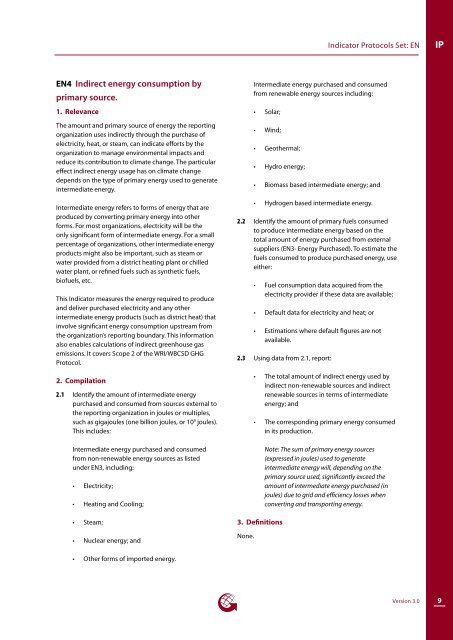Environment - Global Reporting Initiative
Environment - Global Reporting Initiative
Environment - Global Reporting Initiative
You also want an ePaper? Increase the reach of your titles
YUMPU automatically turns print PDFs into web optimized ePapers that Google loves.
Indicator Protocols Set: EN<br />
IP<br />
EN4 Indirect energy consumption by<br />
primary source.<br />
1. Relevance<br />
The amount and primary source of energy the reporting<br />
organization uses indirectly through the purchase of<br />
electricity, heat, or steam, can indicate efforts by the<br />
organization to manage environmental impacts and<br />
reduce its contribution to climate change. The particular<br />
effect indirect energy usage has on climate change<br />
depends on the type of primary energy used to generate<br />
intermediate energy.<br />
Intermediate energy refers to forms of energy that are<br />
produced by converting primary energy into other<br />
forms. For most organizations, electricity will be the<br />
only significant form of intermediate energy. For a small<br />
percentage of organizations, other intermediate energy<br />
products might also be important, such as steam or<br />
water provided from a district heating plant or chilled<br />
water plant, or refined fuels such as synthetic fuels,<br />
biofuels, etc.<br />
This Indicator measures the energy required to produce<br />
and deliver purchased electricity and any other<br />
intermediate energy products (such as district heat) that<br />
involve significant energy consumption upstream from<br />
the organization’s reporting boundary. This information<br />
also enables calculations of indirect greenhouse gas<br />
emissions. It covers Scope 2 of the WRI/WBCSD GHG<br />
Protocol.<br />
2. Compilation<br />
2.1 Identify the amount of intermediate energy<br />
purchased and consumed from sources external to<br />
the reporting organization in joules or multiples,<br />
such as gigajoules (one billion joules, or 10 9 joules).<br />
This includes:<br />
Intermediate energy purchased and consumed<br />
from non-renewable energy sources as listed<br />
under EN3, including:<br />
• Electricity;<br />
• Heating and Cooling;<br />
• Steam;<br />
• Nuclear energy; and<br />
Intermediate energy purchased and consumed<br />
from renewable energy sources including:<br />
• Solar;<br />
• Wind;<br />
• Geothermal;<br />
• Hydro energy;<br />
• Biomass based intermediate energy; and<br />
• Hydrogen based intermediate energy.<br />
2.2 Identify the amount of primary fuels consumed<br />
to produce intermediate energy based on the<br />
total amount of energy purchased from external<br />
suppliers (EN3- Energy Purchased). To estimate the<br />
fuels consumed to produce purchased energy, use<br />
either:<br />
• Fuel consumption data acquired from the<br />
electricity provider if these data are available;<br />
• Default data for electricity and heat; or<br />
• Estimations where default figures are not<br />
available.<br />
2.3 Using data from 2.1, report:<br />
• The total amount of indirect energy used by<br />
indirect non-renewable sources and indirect<br />
renewable sources in terms of intermediate<br />
energy; and<br />
• The corresponding primary energy consumed<br />
in its production.<br />
3. Definitions<br />
None.<br />
Note: The sum of primary energy sources<br />
(expressed in joules) used to generate<br />
intermediate energy will, depending on the<br />
primary source used, significantly exceed the<br />
amount of intermediate energy purchased (in<br />
joules) due to grid and efficiency losses when<br />
converting and transporting energy.<br />
• Other forms of imported energy.<br />
Version 3.0<br />
9

















